Brand Management: Building, Managing & Leveraging Brands Over Time
VerifiedAdded on 2024/04/26
|20
|4132
|58
Report
AI Summary
This report explores the critical aspects of brand management, emphasizing the importance of brand image and its strategic handling within an organization's business framework. It delves into the significance of brand value, both domestically and internationally, and examines the essential elements for constructing a robust brand and managing a diverse brand portfolio. The analysis includes case studies of Nike and Amazon, highlighting their successful strategies in cultivating brand image and achieving customer satisfaction, which has enabled them to capture significant market shares through quality products. Furthermore, the report evaluates the advantages and disadvantages of brand extension strategies and discusses the methods used to assess and manage brand performance effectively, including the CBBE model.

THE BRAND MANAGER
Paraphrase This Document
Need a fresh take? Get an instant paraphrase of this document with our AI Paraphraser
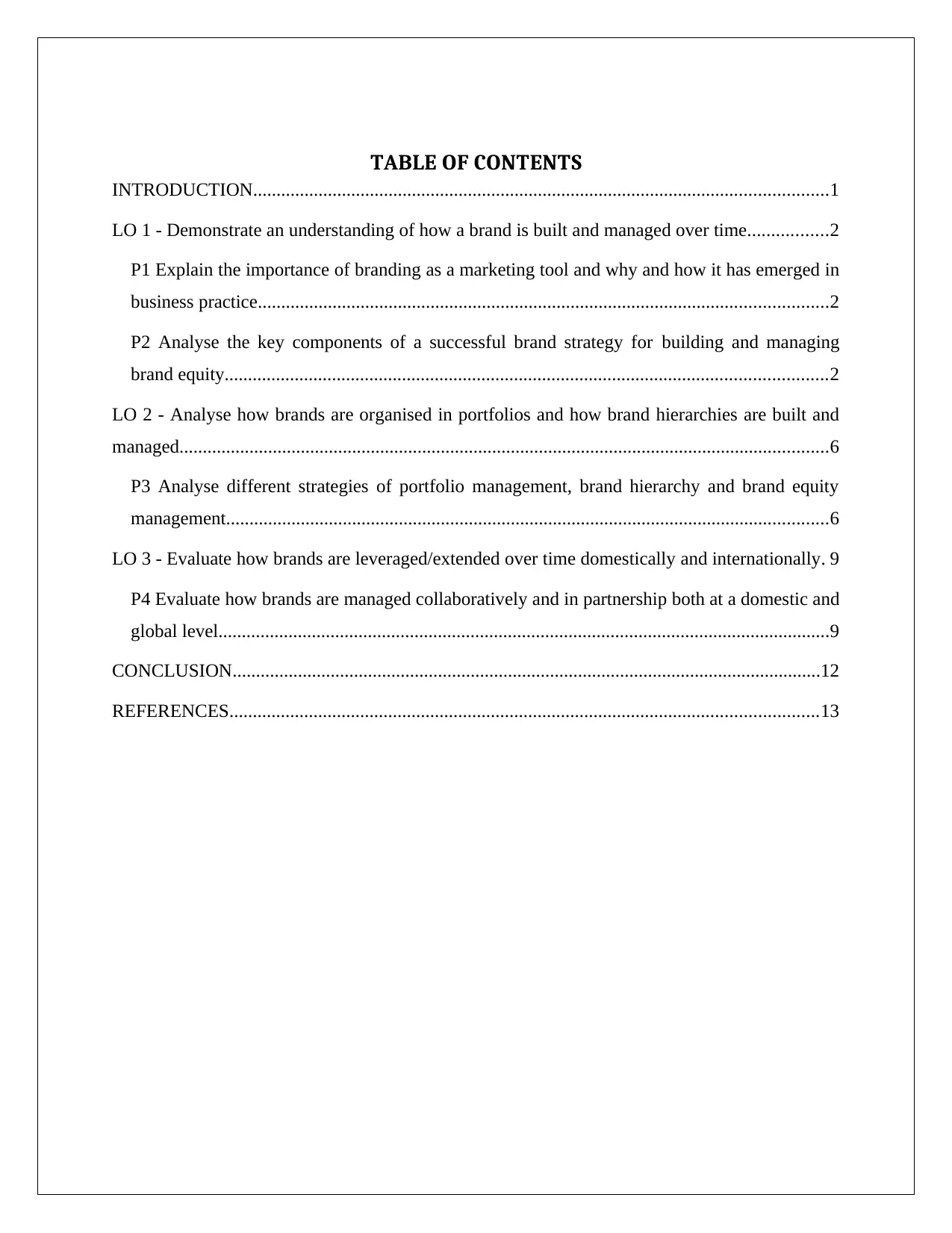
TABLE OF CONTENTS
INTRODUCTION...........................................................................................................................1
LO 1 - Demonstrate an understanding of how a brand is built and managed over time.................2
P1 Explain the importance of branding as a marketing tool and why and how it has emerged in
business practice..........................................................................................................................2
P2 Analyse the key components of a successful brand strategy for building and managing
brand equity.................................................................................................................................2
LO 2 - Analyse how brands are organised in portfolios and how brand hierarchies are built and
managed...........................................................................................................................................6
P3 Analyse different strategies of portfolio management, brand hierarchy and brand equity
management.................................................................................................................................6
LO 3 - Evaluate how brands are leveraged/extended over time domestically and internationally. 9
P4 Evaluate how brands are managed collaboratively and in partnership both at a domestic and
global level...................................................................................................................................9
CONCLUSION..............................................................................................................................12
REFERENCES..............................................................................................................................13
INTRODUCTION...........................................................................................................................1
LO 1 - Demonstrate an understanding of how a brand is built and managed over time.................2
P1 Explain the importance of branding as a marketing tool and why and how it has emerged in
business practice..........................................................................................................................2
P2 Analyse the key components of a successful brand strategy for building and managing
brand equity.................................................................................................................................2
LO 2 - Analyse how brands are organised in portfolios and how brand hierarchies are built and
managed...........................................................................................................................................6
P3 Analyse different strategies of portfolio management, brand hierarchy and brand equity
management.................................................................................................................................6
LO 3 - Evaluate how brands are leveraged/extended over time domestically and internationally. 9
P4 Evaluate how brands are managed collaboratively and in partnership both at a domestic and
global level...................................................................................................................................9
CONCLUSION..............................................................................................................................12
REFERENCES..............................................................................................................................13

LIST OF FIGURES
Figure 1: Factors of brand equity.....................................................................................................3
Figure 2: Products of Nike...............................................................................................................7
Figure 3: Products at Amazon.........................................................................................................7
Figure 4: Model of CBBE................................................................................................................8
Figure 5: Process of Brand Extension.............................................................................................9
Figure 1: Factors of brand equity.....................................................................................................3
Figure 2: Products of Nike...............................................................................................................7
Figure 3: Products at Amazon.........................................................................................................7
Figure 4: Model of CBBE................................................................................................................8
Figure 5: Process of Brand Extension.............................................................................................9
⊘ This is a preview!⊘
Do you want full access?
Subscribe today to unlock all pages.

Trusted by 1+ million students worldwide

LIST OF TABLES
Table 1: Description of elements.....................................................................................................4
Table 2: Advantages and disadvantages of brand extension.........................................................10
Table 1: Description of elements.....................................................................................................4
Table 2: Advantages and disadvantages of brand extension.........................................................10
Paraphrase This Document
Need a fresh take? Get an instant paraphrase of this document with our AI Paraphraser
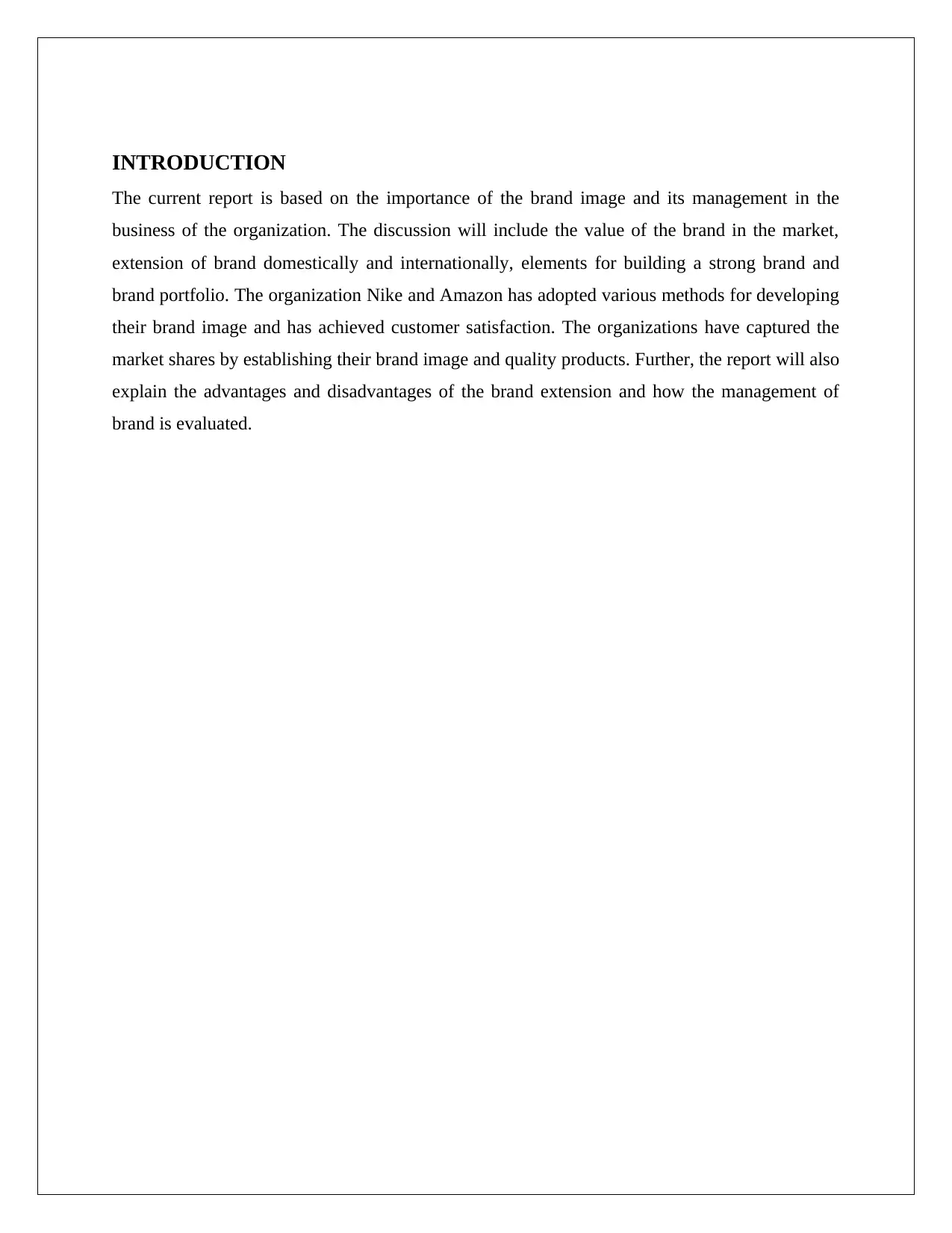
INTRODUCTION
The current report is based on the importance of the brand image and its management in the
business of the organization. The discussion will include the value of the brand in the market,
extension of brand domestically and internationally, elements for building a strong brand and
brand portfolio. The organization Nike and Amazon has adopted various methods for developing
their brand image and has achieved customer satisfaction. The organizations have captured the
market shares by establishing their brand image and quality products. Further, the report will also
explain the advantages and disadvantages of the brand extension and how the management of
brand is evaluated.
The current report is based on the importance of the brand image and its management in the
business of the organization. The discussion will include the value of the brand in the market,
extension of brand domestically and internationally, elements for building a strong brand and
brand portfolio. The organization Nike and Amazon has adopted various methods for developing
their brand image and has achieved customer satisfaction. The organizations have captured the
market shares by establishing their brand image and quality products. Further, the report will also
explain the advantages and disadvantages of the brand extension and how the management of
brand is evaluated.
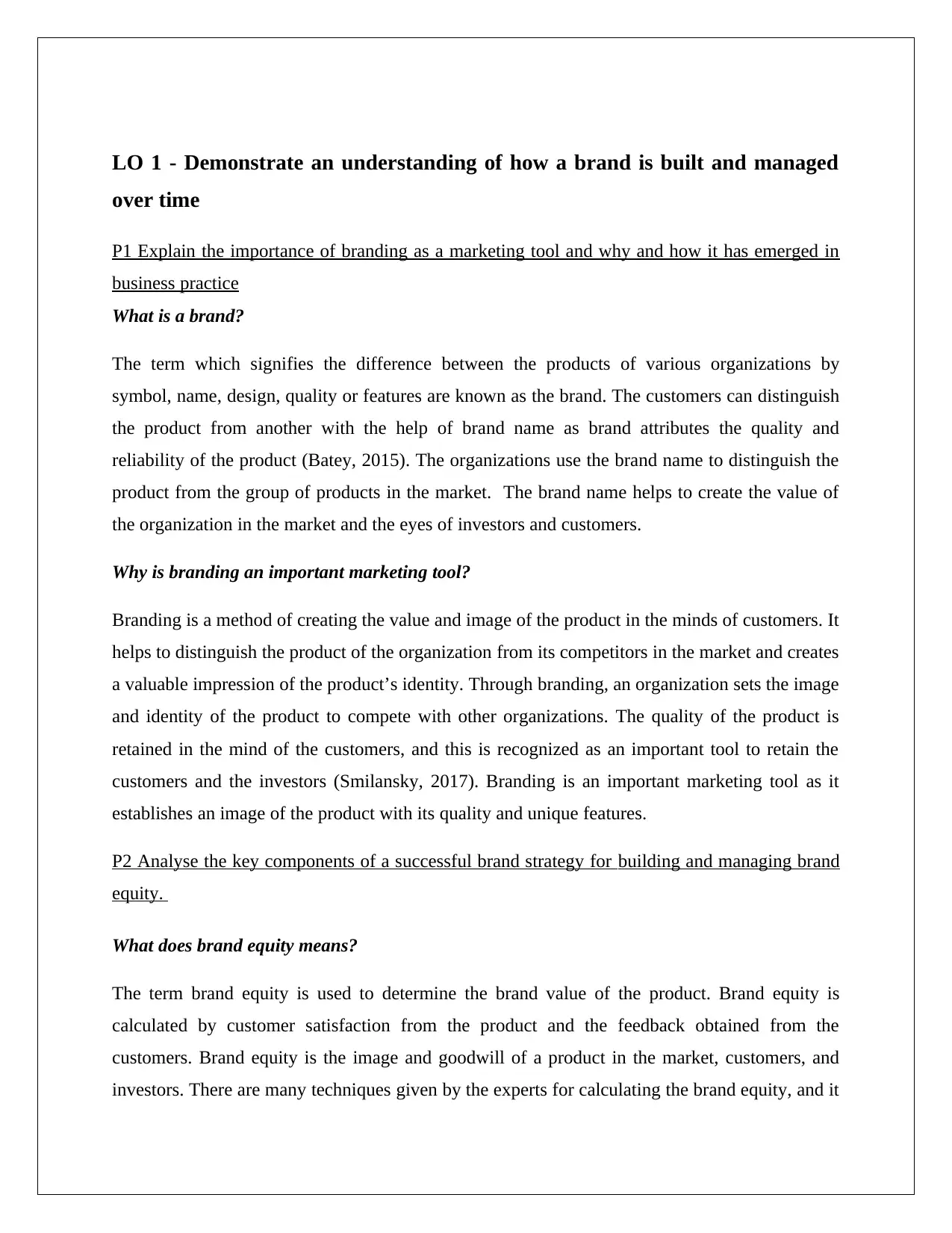
LO 1 - Demonstrate an understanding of how a brand is built and managed
over time
P1 Explain the importance of branding as a marketing tool and why and how it has emerged in
business practice
What is a brand?
The term which signifies the difference between the products of various organizations by
symbol, name, design, quality or features are known as the brand. The customers can distinguish
the product from another with the help of brand name as brand attributes the quality and
reliability of the product (Batey, 2015). The organizations use the brand name to distinguish the
product from the group of products in the market. The brand name helps to create the value of
the organization in the market and the eyes of investors and customers.
Why is branding an important marketing tool?
Branding is a method of creating the value and image of the product in the minds of customers. It
helps to distinguish the product of the organization from its competitors in the market and creates
a valuable impression of the product’s identity. Through branding, an organization sets the image
and identity of the product to compete with other organizations. The quality of the product is
retained in the mind of the customers, and this is recognized as an important tool to retain the
customers and the investors (Smilansky, 2017). Branding is an important marketing tool as it
establishes an image of the product with its quality and unique features.
P2 Analyse the key components of a successful brand strategy for building and managing brand
equity.
What does brand equity means?
The term brand equity is used to determine the brand value of the product. Brand equity is
calculated by customer satisfaction from the product and the feedback obtained from the
customers. Brand equity is the image and goodwill of a product in the market, customers, and
investors. There are many techniques given by the experts for calculating the brand equity, and it
over time
P1 Explain the importance of branding as a marketing tool and why and how it has emerged in
business practice
What is a brand?
The term which signifies the difference between the products of various organizations by
symbol, name, design, quality or features are known as the brand. The customers can distinguish
the product from another with the help of brand name as brand attributes the quality and
reliability of the product (Batey, 2015). The organizations use the brand name to distinguish the
product from the group of products in the market. The brand name helps to create the value of
the organization in the market and the eyes of investors and customers.
Why is branding an important marketing tool?
Branding is a method of creating the value and image of the product in the minds of customers. It
helps to distinguish the product of the organization from its competitors in the market and creates
a valuable impression of the product’s identity. Through branding, an organization sets the image
and identity of the product to compete with other organizations. The quality of the product is
retained in the mind of the customers, and this is recognized as an important tool to retain the
customers and the investors (Smilansky, 2017). Branding is an important marketing tool as it
establishes an image of the product with its quality and unique features.
P2 Analyse the key components of a successful brand strategy for building and managing brand
equity.
What does brand equity means?
The term brand equity is used to determine the brand value of the product. Brand equity is
calculated by customer satisfaction from the product and the feedback obtained from the
customers. Brand equity is the image and goodwill of a product in the market, customers, and
investors. There are many techniques given by the experts for calculating the brand equity, and it
⊘ This is a preview!⊘
Do you want full access?
Subscribe today to unlock all pages.

Trusted by 1+ million students worldwide
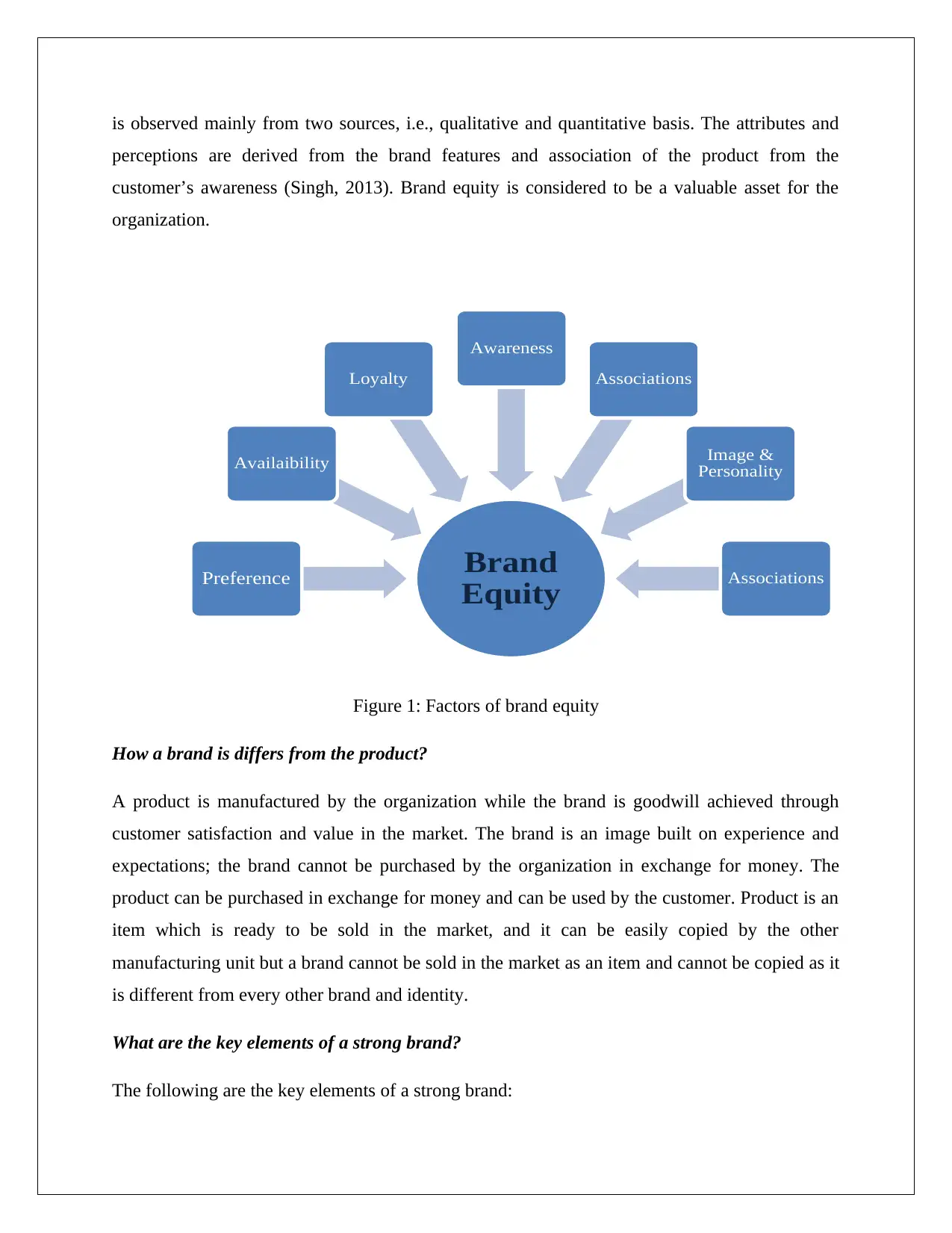
is observed mainly from two sources, i.e., qualitative and quantitative basis. The attributes and
perceptions are derived from the brand features and association of the product from the
customer’s awareness (Singh, 2013). Brand equity is considered to be a valuable asset for the
organization.
Figure 1: Factors of brand equity
How a brand is differs from the product?
A product is manufactured by the organization while the brand is goodwill achieved through
customer satisfaction and value in the market. The brand is an image built on experience and
expectations; the brand cannot be purchased by the organization in exchange for money. The
product can be purchased in exchange for money and can be used by the customer. Product is an
item which is ready to be sold in the market, and it can be easily copied by the other
manufacturing unit but a brand cannot be sold in the market as an item and cannot be copied as it
is different from every other brand and identity.
What are the key elements of a strong brand?
The following are the key elements of a strong brand:
Brand
Equity
Preference
Availaibility
Loyalty
Awareness
Associations
Image &
Personality
Associations
perceptions are derived from the brand features and association of the product from the
customer’s awareness (Singh, 2013). Brand equity is considered to be a valuable asset for the
organization.
Figure 1: Factors of brand equity
How a brand is differs from the product?
A product is manufactured by the organization while the brand is goodwill achieved through
customer satisfaction and value in the market. The brand is an image built on experience and
expectations; the brand cannot be purchased by the organization in exchange for money. The
product can be purchased in exchange for money and can be used by the customer. Product is an
item which is ready to be sold in the market, and it can be easily copied by the other
manufacturing unit but a brand cannot be sold in the market as an item and cannot be copied as it
is different from every other brand and identity.
What are the key elements of a strong brand?
The following are the key elements of a strong brand:
Brand
Equity
Preference
Availaibility
Loyalty
Awareness
Associations
Image &
Personality
Associations
Paraphrase This Document
Need a fresh take? Get an instant paraphrase of this document with our AI Paraphraser
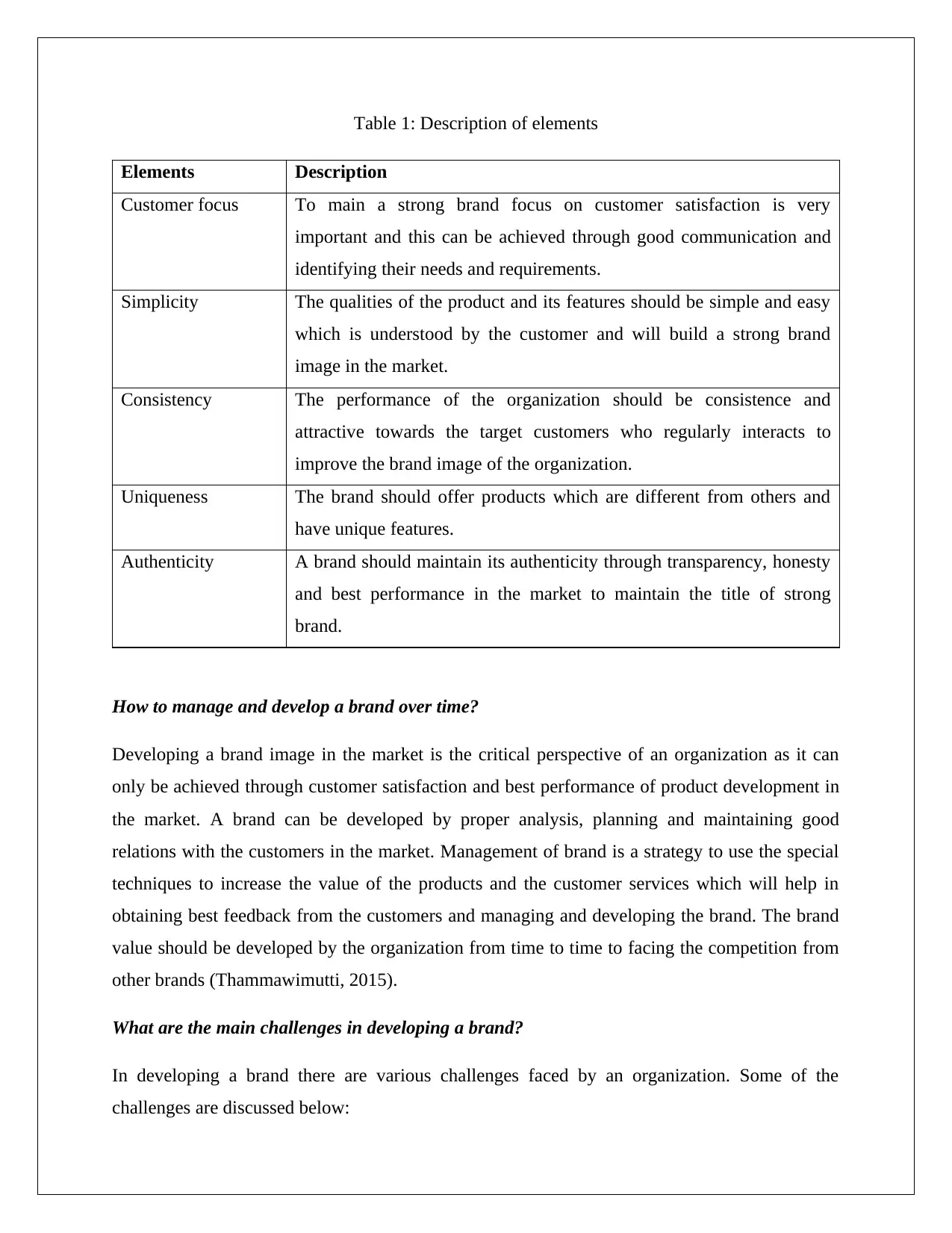
Table 1: Description of elements
Elements Description
Customer focus To main a strong brand focus on customer satisfaction is very
important and this can be achieved through good communication and
identifying their needs and requirements.
Simplicity The qualities of the product and its features should be simple and easy
which is understood by the customer and will build a strong brand
image in the market.
Consistency The performance of the organization should be consistence and
attractive towards the target customers who regularly interacts to
improve the brand image of the organization.
Uniqueness The brand should offer products which are different from others and
have unique features.
Authenticity A brand should maintain its authenticity through transparency, honesty
and best performance in the market to maintain the title of strong
brand.
How to manage and develop a brand over time?
Developing a brand image in the market is the critical perspective of an organization as it can
only be achieved through customer satisfaction and best performance of product development in
the market. A brand can be developed by proper analysis, planning and maintaining good
relations with the customers in the market. Management of brand is a strategy to use the special
techniques to increase the value of the products and the customer services which will help in
obtaining best feedback from the customers and managing and developing the brand. The brand
value should be developed by the organization from time to time to facing the competition from
other brands (Thammawimutti, 2015).
What are the main challenges in developing a brand?
In developing a brand there are various challenges faced by an organization. Some of the
challenges are discussed below:
Elements Description
Customer focus To main a strong brand focus on customer satisfaction is very
important and this can be achieved through good communication and
identifying their needs and requirements.
Simplicity The qualities of the product and its features should be simple and easy
which is understood by the customer and will build a strong brand
image in the market.
Consistency The performance of the organization should be consistence and
attractive towards the target customers who regularly interacts to
improve the brand image of the organization.
Uniqueness The brand should offer products which are different from others and
have unique features.
Authenticity A brand should maintain its authenticity through transparency, honesty
and best performance in the market to maintain the title of strong
brand.
How to manage and develop a brand over time?
Developing a brand image in the market is the critical perspective of an organization as it can
only be achieved through customer satisfaction and best performance of product development in
the market. A brand can be developed by proper analysis, planning and maintaining good
relations with the customers in the market. Management of brand is a strategy to use the special
techniques to increase the value of the products and the customer services which will help in
obtaining best feedback from the customers and managing and developing the brand. The brand
value should be developed by the organization from time to time to facing the competition from
other brands (Thammawimutti, 2015).
What are the main challenges in developing a brand?
In developing a brand there are various challenges faced by an organization. Some of the
challenges are discussed below:
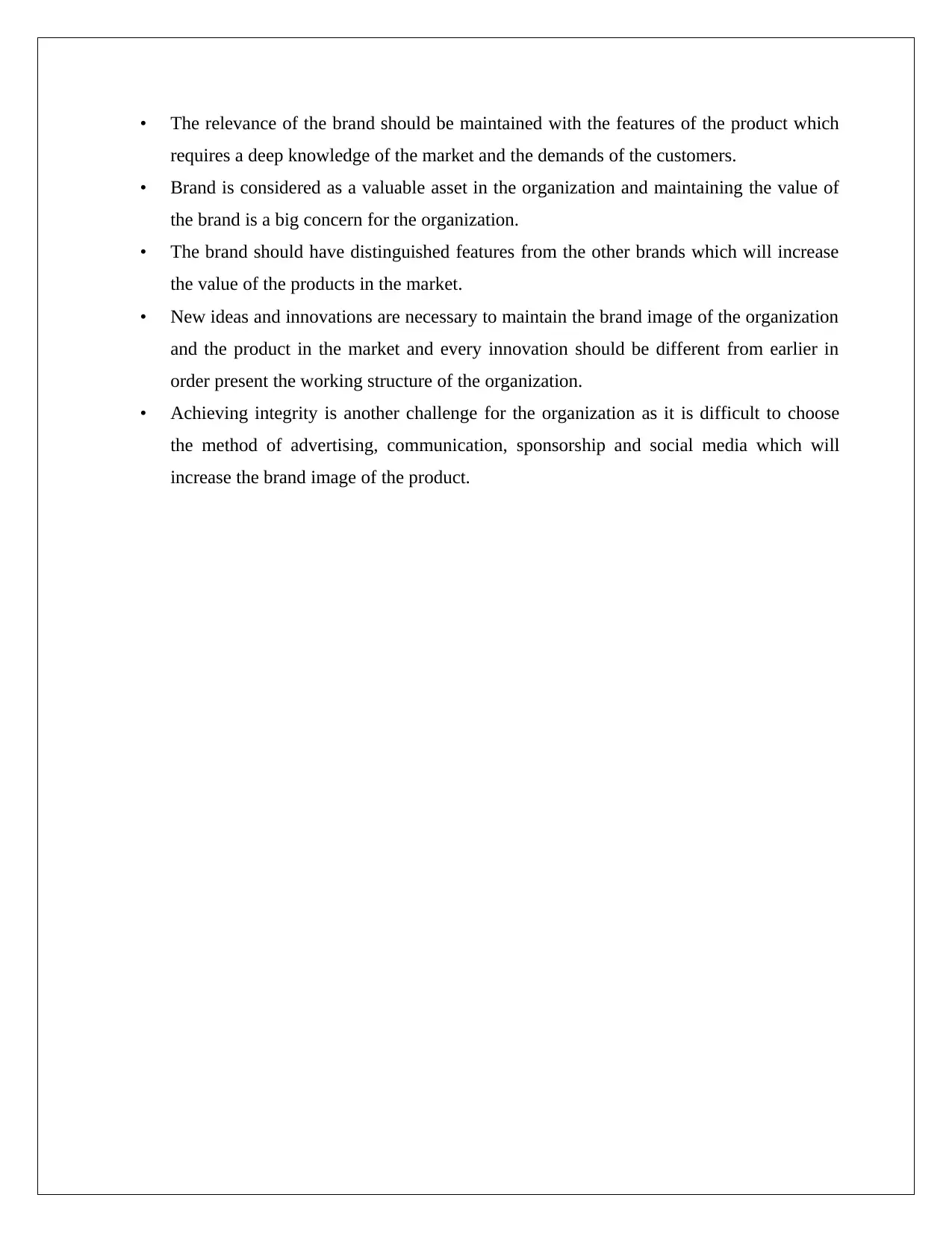
• The relevance of the brand should be maintained with the features of the product which
requires a deep knowledge of the market and the demands of the customers.
• Brand is considered as a valuable asset in the organization and maintaining the value of
the brand is a big concern for the organization.
• The brand should have distinguished features from the other brands which will increase
the value of the products in the market.
• New ideas and innovations are necessary to maintain the brand image of the organization
and the product in the market and every innovation should be different from earlier in
order present the working structure of the organization.
• Achieving integrity is another challenge for the organization as it is difficult to choose
the method of advertising, communication, sponsorship and social media which will
increase the brand image of the product.
requires a deep knowledge of the market and the demands of the customers.
• Brand is considered as a valuable asset in the organization and maintaining the value of
the brand is a big concern for the organization.
• The brand should have distinguished features from the other brands which will increase
the value of the products in the market.
• New ideas and innovations are necessary to maintain the brand image of the organization
and the product in the market and every innovation should be different from earlier in
order present the working structure of the organization.
• Achieving integrity is another challenge for the organization as it is difficult to choose
the method of advertising, communication, sponsorship and social media which will
increase the brand image of the product.
⊘ This is a preview!⊘
Do you want full access?
Subscribe today to unlock all pages.

Trusted by 1+ million students worldwide
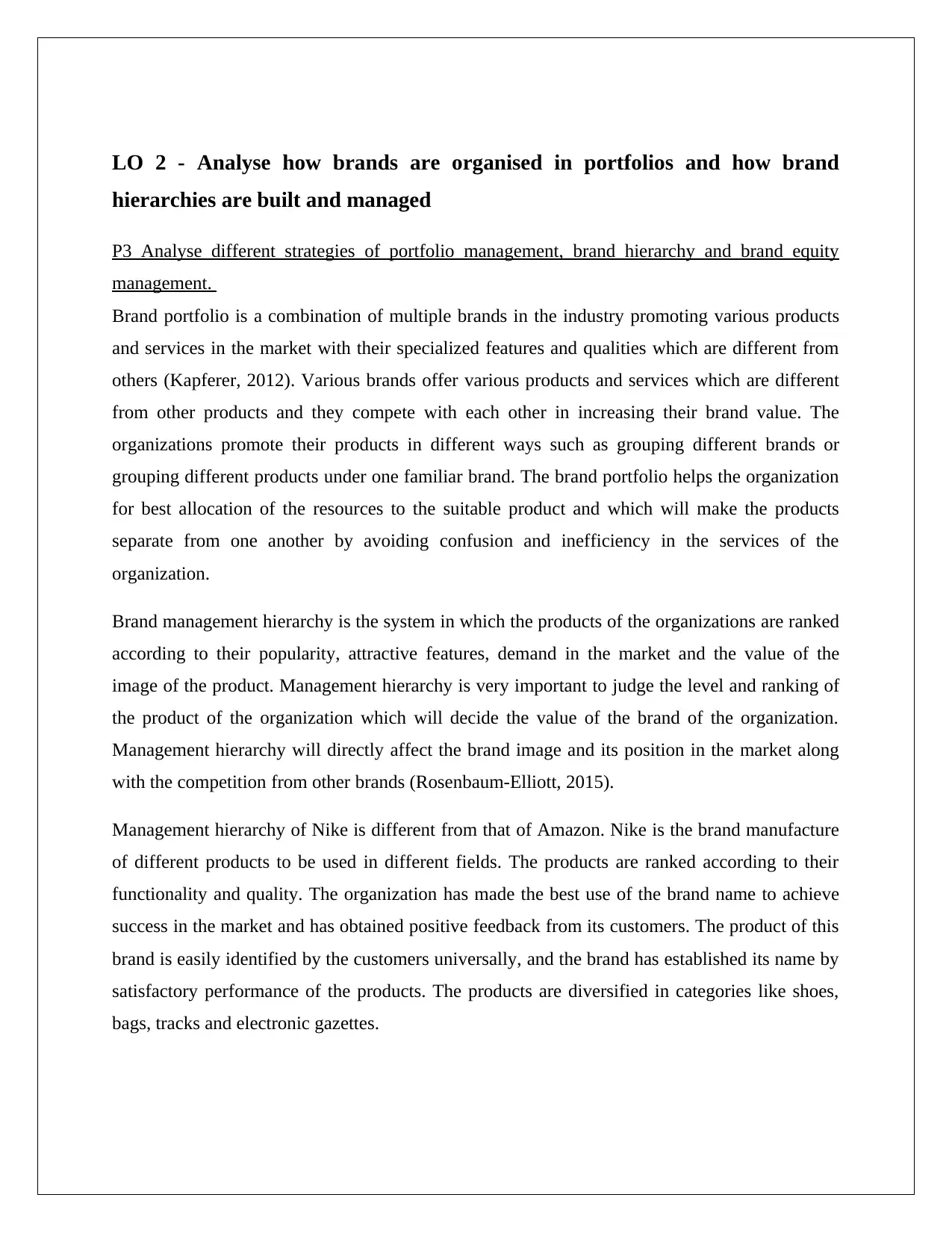
LO 2 - Analyse how brands are organised in portfolios and how brand
hierarchies are built and managed
P3 Analyse different strategies of portfolio management, brand hierarchy and brand equity
management.
Brand portfolio is a combination of multiple brands in the industry promoting various products
and services in the market with their specialized features and qualities which are different from
others (Kapferer, 2012). Various brands offer various products and services which are different
from other products and they compete with each other in increasing their brand value. The
organizations promote their products in different ways such as grouping different brands or
grouping different products under one familiar brand. The brand portfolio helps the organization
for best allocation of the resources to the suitable product and which will make the products
separate from one another by avoiding confusion and inefficiency in the services of the
organization.
Brand management hierarchy is the system in which the products of the organizations are ranked
according to their popularity, attractive features, demand in the market and the value of the
image of the product. Management hierarchy is very important to judge the level and ranking of
the product of the organization which will decide the value of the brand of the organization.
Management hierarchy will directly affect the brand image and its position in the market along
with the competition from other brands (Rosenbaum-Elliott, 2015).
Management hierarchy of Nike is different from that of Amazon. Nike is the brand manufacture
of different products to be used in different fields. The products are ranked according to their
functionality and quality. The organization has made the best use of the brand name to achieve
success in the market and has obtained positive feedback from its customers. The product of this
brand is easily identified by the customers universally, and the brand has established its name by
satisfactory performance of the products. The products are diversified in categories like shoes,
bags, tracks and electronic gazettes.
hierarchies are built and managed
P3 Analyse different strategies of portfolio management, brand hierarchy and brand equity
management.
Brand portfolio is a combination of multiple brands in the industry promoting various products
and services in the market with their specialized features and qualities which are different from
others (Kapferer, 2012). Various brands offer various products and services which are different
from other products and they compete with each other in increasing their brand value. The
organizations promote their products in different ways such as grouping different brands or
grouping different products under one familiar brand. The brand portfolio helps the organization
for best allocation of the resources to the suitable product and which will make the products
separate from one another by avoiding confusion and inefficiency in the services of the
organization.
Brand management hierarchy is the system in which the products of the organizations are ranked
according to their popularity, attractive features, demand in the market and the value of the
image of the product. Management hierarchy is very important to judge the level and ranking of
the product of the organization which will decide the value of the brand of the organization.
Management hierarchy will directly affect the brand image and its position in the market along
with the competition from other brands (Rosenbaum-Elliott, 2015).
Management hierarchy of Nike is different from that of Amazon. Nike is the brand manufacture
of different products to be used in different fields. The products are ranked according to their
functionality and quality. The organization has made the best use of the brand name to achieve
success in the market and has obtained positive feedback from its customers. The product of this
brand is easily identified by the customers universally, and the brand has established its name by
satisfactory performance of the products. The products are diversified in categories like shoes,
bags, tracks and electronic gazettes.
Paraphrase This Document
Need a fresh take? Get an instant paraphrase of this document with our AI Paraphraser
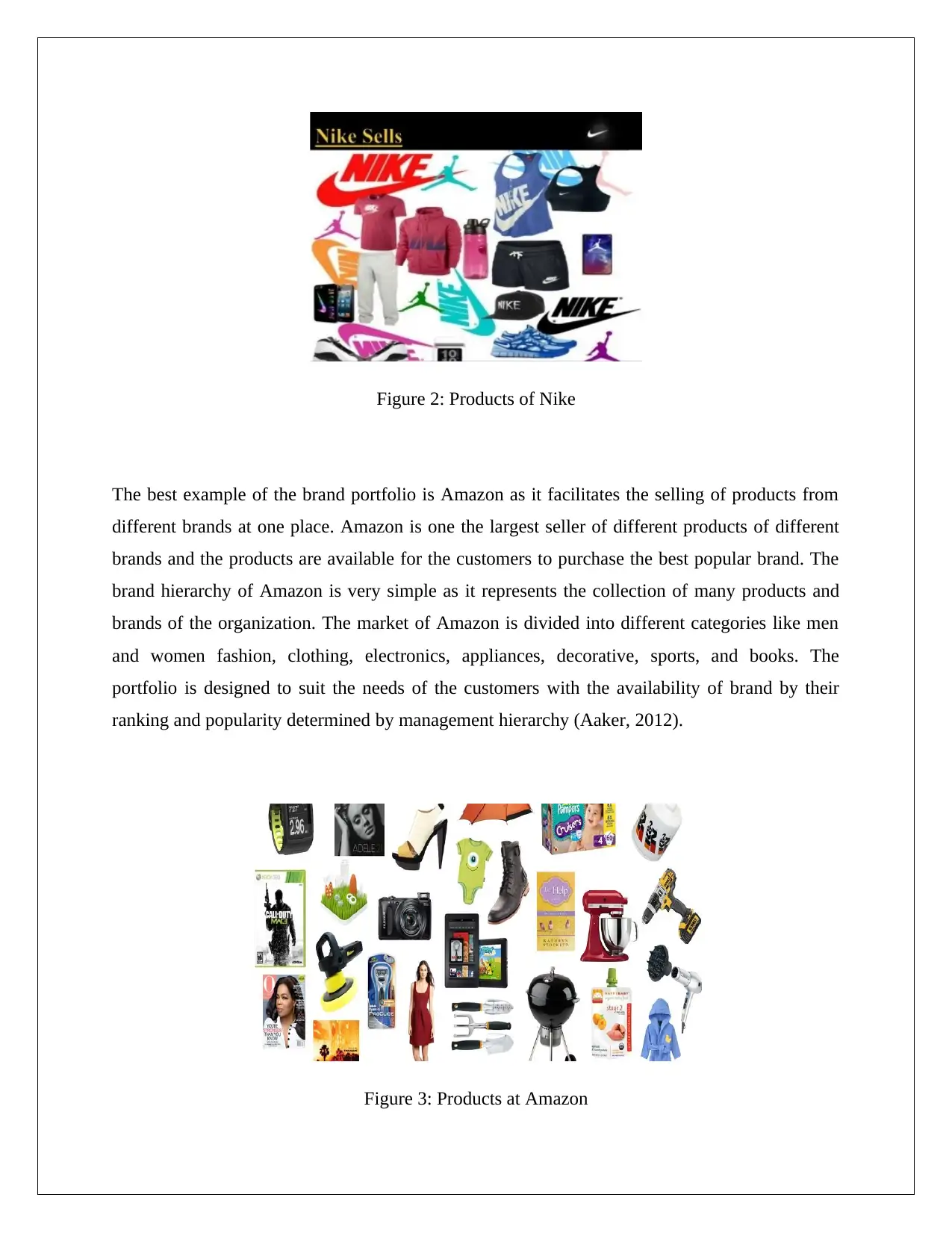
Figure 2: Products of Nike
The best example of the brand portfolio is Amazon as it facilitates the selling of products from
different brands at one place. Amazon is one the largest seller of different products of different
brands and the products are available for the customers to purchase the best popular brand. The
brand hierarchy of Amazon is very simple as it represents the collection of many products and
brands of the organization. The market of Amazon is divided into different categories like men
and women fashion, clothing, electronics, appliances, decorative, sports, and books. The
portfolio is designed to suit the needs of the customers with the availability of brand by their
ranking and popularity determined by management hierarchy (Aaker, 2012).
Figure 3: Products at Amazon
The best example of the brand portfolio is Amazon as it facilitates the selling of products from
different brands at one place. Amazon is one the largest seller of different products of different
brands and the products are available for the customers to purchase the best popular brand. The
brand hierarchy of Amazon is very simple as it represents the collection of many products and
brands of the organization. The market of Amazon is divided into different categories like men
and women fashion, clothing, electronics, appliances, decorative, sports, and books. The
portfolio is designed to suit the needs of the customers with the availability of brand by their
ranking and popularity determined by management hierarchy (Aaker, 2012).
Figure 3: Products at Amazon
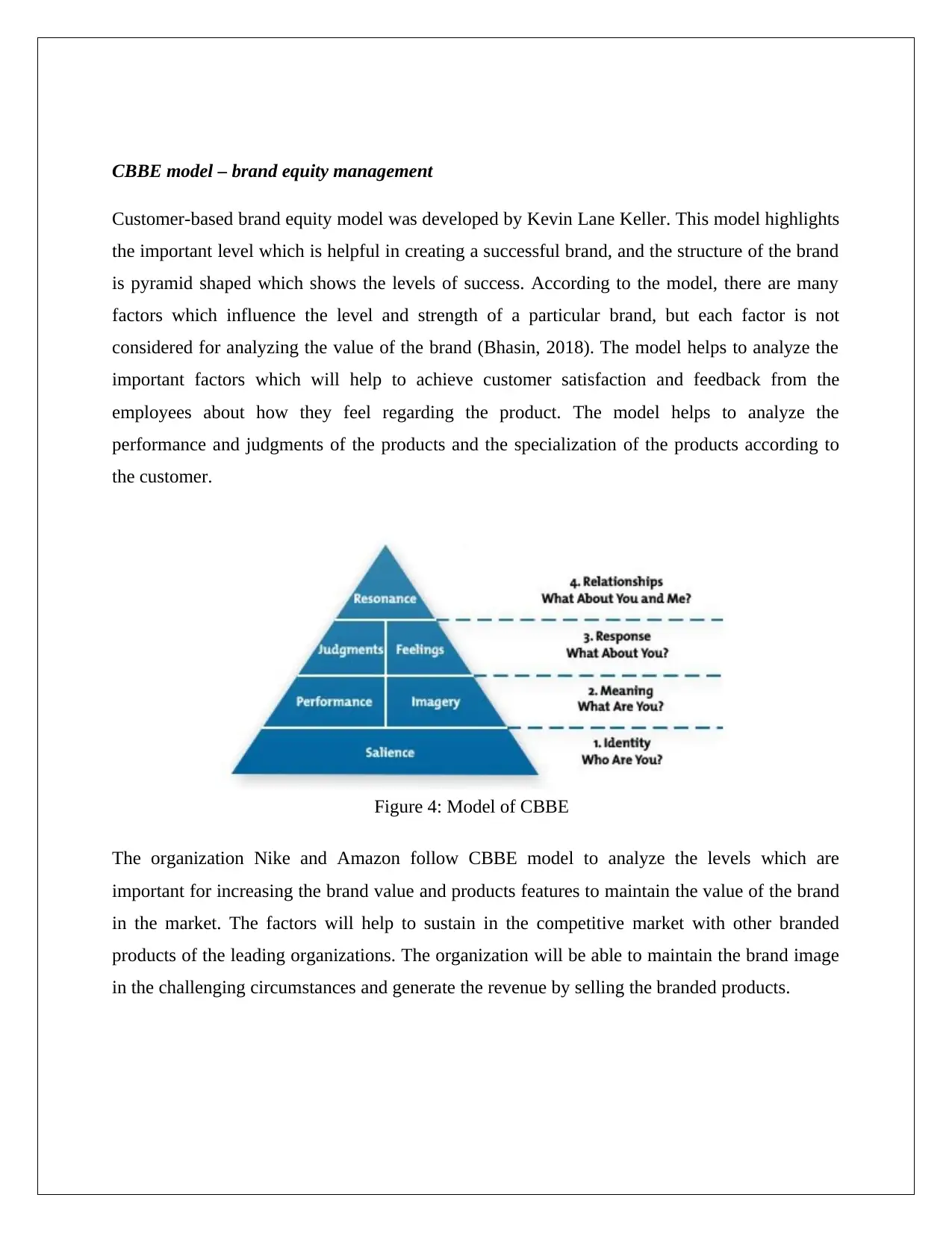
CBBE model – brand equity management
Customer-based brand equity model was developed by Kevin Lane Keller. This model highlights
the important level which is helpful in creating a successful brand, and the structure of the brand
is pyramid shaped which shows the levels of success. According to the model, there are many
factors which influence the level and strength of a particular brand, but each factor is not
considered for analyzing the value of the brand (Bhasin, 2018). The model helps to analyze the
important factors which will help to achieve customer satisfaction and feedback from the
employees about how they feel regarding the product. The model helps to analyze the
performance and judgments of the products and the specialization of the products according to
the customer.
The organization Nike and Amazon follow CBBE model to analyze the levels which are
important for increasing the brand value and products features to maintain the value of the brand
in the market. The factors will help to sustain in the competitive market with other branded
products of the leading organizations. The organization will be able to maintain the brand image
in the challenging circumstances and generate the revenue by selling the branded products.
Figure 4: Model of CBBE
Customer-based brand equity model was developed by Kevin Lane Keller. This model highlights
the important level which is helpful in creating a successful brand, and the structure of the brand
is pyramid shaped which shows the levels of success. According to the model, there are many
factors which influence the level and strength of a particular brand, but each factor is not
considered for analyzing the value of the brand (Bhasin, 2018). The model helps to analyze the
important factors which will help to achieve customer satisfaction and feedback from the
employees about how they feel regarding the product. The model helps to analyze the
performance and judgments of the products and the specialization of the products according to
the customer.
The organization Nike and Amazon follow CBBE model to analyze the levels which are
important for increasing the brand value and products features to maintain the value of the brand
in the market. The factors will help to sustain in the competitive market with other branded
products of the leading organizations. The organization will be able to maintain the brand image
in the challenging circumstances and generate the revenue by selling the branded products.
Figure 4: Model of CBBE
⊘ This is a preview!⊘
Do you want full access?
Subscribe today to unlock all pages.

Trusted by 1+ million students worldwide
1 out of 20
Related Documents
Your All-in-One AI-Powered Toolkit for Academic Success.
+13062052269
info@desklib.com
Available 24*7 on WhatsApp / Email
![[object Object]](/_next/static/media/star-bottom.7253800d.svg)
Unlock your academic potential
Copyright © 2020–2025 A2Z Services. All Rights Reserved. Developed and managed by ZUCOL.




